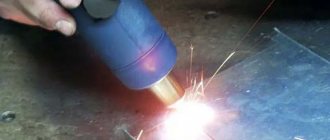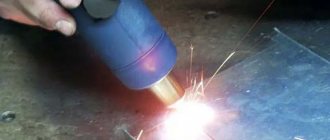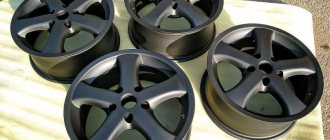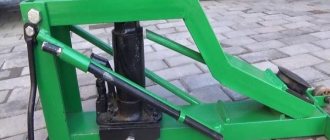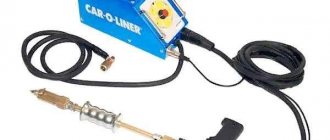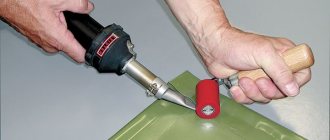Many of those who have had to deal with straightening car body parts know firsthand what spotters are and how convenient they are when performing such work. These devices got their name from the English phrase spot welding, which means “spot welding”. The spotter uses one of the varieties of this technology - one-sided spot welding, which does not require access to the back side of the part. Therefore, a spotter is used for straightening and upsetting defects in body elements to which two-way access is impossible or difficult.
The spotter consists of a pulse-controlled welding machine and a hand-held device, which is commonly called a gun. It is equipped with various attachments, which allows them to perform various types of work: spot welding, mechanical drawing and metal annealing. In its most general form, the technology for straightening a body part using a spotter looks like this: special fasteners (rings, studs, etc.) are welded to a dent in the metal, then the body metal is pulled upward using a mechanical device, after which the fasteners are removed.
What is a spotter and how does it work? Repair technology. Video.
Professional body repair cannot do without using a spotter! In this article we will talk about how to work as a spotter! This device allows you to significantly save time when straightening metal.
If earlier, when there were only improvised means such as mounting, “springs”, hammers, shovels and many other pieces of iron, you had to, for example, disassemble the door and tap the metal from the inside, now with the use of a spotter, you can forget about this extra work. I am sure that after purchasing such a device, you will breathe a sigh of relief and straightening dents will be a mere trifle. The biggest advantage of the spotter is that the force is applied only to the outer surface of the damaged part, thereby making the task much easier. Now let's look at the capabilities and operating principle of this device. First of all, a sopotter or also called a spot is a welding machine for contact welding. The difference between a spotter and a conventional welding machine is that the welding current pulse is formed due to the discharge of a high-capacity capacitor and operates for a very short period of time, so short that even the paint on the reverse side does not have time to burn. But try to perform such a trick with an ordinary semi-automatic machine and what will happen? Therefore, the spotter is not a replaceable device for body repair.
Now, of course, we could talk about who invented this device and when, then we would smoothly move on to physics, the properties of metal and so on, but I think this is of little interest to anyone, and there is no need to bother yourself with unnecessary things. After all, for a body repair specialist, what is primarily important is the quality of the repair, and not the physical and chemical properties of the materials.
Methods of working with a spotter
The principle of operation of the device for straightening dents in those places of the body, which cannot be approached from the reverse side without serious disassembly of the upholstery or structures and components of the car, is based on pulling out the dented area of the surface by a temporarily welded fastener - a mounting washer or a metal rod. The force created by the reverse hammer is directed from the inside of the body to the outside of the dented surface, simulating blows with a mallet from an inaccessible place.
Do-it-yourself spotter at work
The technological process can be divided into the following operations:
- Remove paint, soil and dirt from the center of the dented area of the body - it must be stripped down to bare metal.
- Connect the ground of the spotter to the car body. The vehicle battery must be disconnected and the ignition turned off to avoid damage to electrical equipment from welding current pulses.
- Spot weld the fasteners to the center of the dent.
- Straighten out the dent by pulling out the metal by the fastener.
- Using a twisting motion, remove the fasteners from the leveled surface.
- Clean the place where the washer or electrode is attached and prepare the body element for painting.
To work with a spotter, store-bought or home-made, the master will only need general welding and plumbing skills. It is necessary to comply with industrial safety requirements in order to avoid harm to human life and health and damage to material assets.
What is a spotter and how does it work? Which device should I choose?
A spotter is one of the most modern and technologically advanced tools focused on spot welding. Its main purpose is body repair, restoration of metal elements of transport units.
The principle of operation is identical to other welding machines; it lies in the fact that it releases thermal energy at the point where the materials being welded come into contact with each other. Energy is released when an electric current passes.
The spotter allows you to work with all body parts, but it is most effective when manipulating volumetric elements, access to the reverse side of which is difficult. The advantage of the device in this case is that the material can be straightened without dismantling.
In such a situation, the pulling technique is used. A fastener is fixed on the defective surface, thanks to which it is possible to pull out the dent.
The average thickness of the metal of body panels is one and a half millimeters, and therefore no problems arise with the implementation of this technology.
Main manufacturers and models
Spotters are specialized equipment, so compared to other welding machines on the market, they are represented by a much smaller number of models.
Perhaps the most famous among them are the Italian Telwin and the German Garwin and Nordeberg. All these companies produce quite expensive inverter models with the widest range of functionality. The rest of the range is represented by well-known and little-known brands that produce their equipment in China. Among them we can note the German brand Fubag, which produces a variety of welding equipment with a good reputation. In articles about spotters, there are sometimes statements that in spot welding mode you can use welding inverters with manual mode (MMA). Considering the difference in open circuit voltages (even taking into account the possibility of regulation), this looks rather doubtful. What do you think about this? Please share your opinion in the comments.
Spotter: what is it and why is it needed?
Work related to straightening a car does not always come down to basic skills in working with tools. Accuracy and knowledge of the design and geometric features of body parts are often required. Even if you have the knowledge, you will need an auxiliary, specialized tool, which is a spotter. What is a spotter and how it works, we will consider further.
Features of straightening
Let's look at what a straightening spotter is and how to use it. The principle of eliminating damage is the same for dents, regardless of their size:
- Cleaning and preparing repair areas.
- Installation of the ground terminal.
- Fixing the tip of the electrode of the equipment or the consumable washer on the dent.
- Pulling metal using lever systems, pullers, blows of a reverse hammer, as well as other methods
- Subsequent finishing.
For small dents, a lever puller is sufficient
Dents that occupy a large area and have a complex shape are straightened using a reverse hammer.
Repairing serious damage, such as deep longitudinal dents, requires the use of additional consumables.
Spotter, what is it?
Every straightener knows what a spotter is; it is indispensable for most body restoration work. A spotter for body repair is a device that helps prevent the complete dismantling of body elements during straightening work. The surface on the car using the device is displayed in any place, regardless of accessibility.
Spotter has an important advantage - it helps restore complex geometry on any body parts. The device is especially effective in places where there is no access to the inside of the element. Working as a spotter is not difficult, and this has contributed to the spread of the device. Additionally, powerful devices are used instead of spot welding.
The device is universal and allows you to straighten various body parts: door, hood, fender, threshold, etc. The main difference of the device is the creation of straightening forces with fixation to the outside of the body part.
Professional body repair cannot do without using a spotter
Main components for assembly
To assemble and test a homemade spotter, you need the following components and consumables:
- Frame. Sheet metal box structure with front and back panels. Ventilation holes and a ground terminal are required.
- Power supply. In its simplest form, it is a do-it-yourself transformer with a circuit breaker in the primary circuit.
- Power cables. The welding cable must have a terminal for connection to power and a threaded contact for connection to the gun, and the ground cable must have a terminal and contact pad for welding connection to the body part.
- Control circuit. The minimum version includes a switch button on the gun, an input voltage cut-off relay, control wires and a control circuit power supply.
- Welding gun. At one end there is a contact threaded connection for connecting electrodes and adapters, and at the other there is a socket for connecting a welding cable.
- Equipment. The basic version includes electrodes for washers and pins, a return hammer and an adapter for connecting a carbon electrode.
Assembling a reverse hammer (inopuller) with your own hands
In order to assemble a reverse hammer with your own hands, you need the following parts:
- steel rod 60 cm long, 17 mm in diameter, with threads on both ends;
- steel bushing with a through hole with a diameter of 15 mm, a length of 15 cm and a diameter of 40 mm;
- return spring;
- travel stop nuts and washers;
- adapters for attaching electrodes.
First, a washer is put on the end of the rod intended for fastening into the gun and the nut is tightened tightly. The rod is then passed through the bushing and return spring. The final step is to attach a washer and nut to the bottom threads, and then screw on the electrode adapter. During operation, the massive bushing will be repelled by the spring and perform reciprocating movements between the two washers.
Making a working pistol
Branded spotter pistols are usually produced in the form of devices with a pistol grip. Much of what folk craftsmen make with their own hands can only conditionally be called a “pistol.” Often it is just a cylinder with a button and a terminal for connecting a cable at the end. This is because the spotter gun consists of only three parts: the body, the contact rod and the switch. The contact rod is usually made of brass. At one end there is a thread for attaching a reverse hammer, and at the other there is a clamp for connecting power. For those who make such devices with their own hands, whether to place it in a pistol case or use it as is is a matter of personal preference. At the same time, despite the low welding voltage, it must be insulated: these are the requirements of safety regulations.
Transformer for spotter
Any transformer is suitable for making a power source for a spotter. Videos of the manufacture of spot welding machines based on transformers of microwave ovens and other household appliances are distributed on the Internet.
At the same time, the authors of these crafts do not inform what current their devices are designed for, and this is very important, because
The penetration of the metal surface during operation of the spotter should occur in a fraction of seconds, without appearing in any way on the back side of the part. Factory devices have a power of 3÷5 kW with an open circuit voltage of 7÷8 V (welding voltage - 1.5÷2 V).
For a spotter assembled by yourself and intended only for body repairs, a power of 1.5÷2 kW is sufficient. It is not difficult to calculate how many turns there should be in the secondary winding of a transformer. To do this, the number of turns of the primary winding (new) must be divided by the quotient of 220 divided by 7 ÷ 8. Usually it turns out just a few turns.
Control unit diagram
There are quite a lot of electronic circuits on the Internet that are labeled as spotter control units. Some of them refer to industrial designs of spot welding installations (including old ones), others are replete with electronic components and have redundant parameters, and a number of circuits are not at all related to our topic. Many of the proposed devices implement adjustments to the open circuit current and voltage, as well as control of the duration of the welding pulse. Their manufacture requires a certain skill, and the parts used are not that cheap. Choosing one of these schemes is advisable if you plan to make a spotter for commercial use in a small auto repair shop. And for devices that are made by hand and used at home, there are simpler solutions.
Design and principle of operation
Working as a spotter involves heating a small area of a body element; the effect causes minimal damage to the car.
The welding algorithm includes the following stages:
- A fastening element is welded to the damage site.
- The reverse hammer is hooked onto the latch.
- Pulling is done manually, but auxiliary tools are often used.
Straightening with a spotter is carried out without much effort, this allows you to carry out repairs in any garage.
Scheme of an elementary unit:
- frame;
- cable;
- studder (nozzle);
- electrode (can be replaced with a sharp twist).
Any box serves as a housing to which all components of the device are attached.
The main design element is the welding gun. The homemade version does not allow long-term operation and is somewhat inferior in characteristics, but is suitable for work with small volumes of straightening. Long-term operation is implemented in a factory device.
The biggest advantage of the spotter is that the force is applied only to the outer surface of the damaged part
Design features and operating parameters
So, spotter. What it is? Let's look at it in more detail.
The device is formed by the following modules:
- a device through which resistance welding is carried out;
- ground cable;
- a current supply cable, at the end of which a welding gun is attached - the main working element.
The gun can be equipped with various types of attachments, which are selected depending on the specific operations to be performed.
On the front panel of the welding machine there are controls that allow you to adjust the power and current.
The most modern modifications are equipped with liquid crystal displays, allowing you to see current performance indicators and keep the entire process under control.
Main varieties
Devices are presented in the following categories:
1. Inverter.
This equipment is equipped with converters, thanks to which they operate regardless of voltage. This simplifies the work and also expands the list of tasks available for implementation.
The devices are compact, allow welding with high precision and speed, the current strength remains stable throughout the entire process.
2. Transformer . Such spotters are connected to AC networks, they are cheaper than inverter analogs, and their functions are quite sufficient to perform simple operations.
Three-phase devices are considered the most functional models in this category, which is explained by their increased power. The main disadvantage of transformer technology is that it is not suitable for working with metal coated with a layer of zinc.
Classification is also allowed according to the materials with which operations are carried out:
3. Spotter for steel . The most common device that allows operations with steel body parts.
4. Models focused on working with aluminum . This metal has completely different characteristics compared to steel, and therefore it is necessary to work with it using appropriate devices.
Watch a useful video about what a spotter is and how to use it:
Principles of choice
To choose a spotter that will be truly useful and functional, you need to be guided by the following points:
- For professional use, it is better to choose the most functional device, with an abundance of operating modes. It will allow you to carry out a whole range of straightening work and eliminate the need to purchase additional tools.
- Working with metal sheets with a thickness of more than 1.5 millimeters involves the use of models with double-sided welding. If the specified value is less, then a one-sided option is sufficient.
For home use, a simple model with an average power rating is enough. It is quite enough to level out dents that are not too deep.
Let's also study a brief rating of spotters:
- GS series from the Garwin brand . A fairly affordable price and a functional set that is quite suitable even for professional use.
- Hammer TT series . High level of safety, digital control, allowing you to control operating parameters with maximum accuracy. The power is quite sufficient for home use.
- Gyspot . High-quality equipment from a French manufacturer.
Read also: Mercedes 123 interior photos
Watch a video review of a person using a spotter - RedHotDot HAMMER TT:
Useful video review of the French Spottera GYSpot 2700 for body repair:
Reviews also make it clear that devices from Russian masters and foreign companies Holex, Aurora, Telwin have proven themselves well.
Video of working with the spotter:
There is a certain technology of work when it is impossible to get to parts with dents from the back side of the dent. This method is especially often used to fix sills, doors or rear fenders. The technique is based on the fact that the force is applied only to the outer side of the surface. This work is done by a spotter (spot – dot). It is a single-phase electronic air-cooled pneumatic spot welding machine controlled by a microprocessor, which is equipped with a multi-function control panel, it is used to automatically change the spot welding parameters according to the selected tool and the thickness of the metal sheets, as well as the contact time and its force.
This is painstaking and time-consuming work, because... it represents the following. One-sided spot welding, produced by a device with the release of a large amount of heat at the point of contact, occurs when current is supplied, then with the help of a stop or using an inertial (reverse) hammer, and sometimes lever devices, a very small local surface is leveled. And thus, passing the entire surface of the dent centimeter by centimeter, we gradually “pull out” it to its original position.
Then it is sanded to remove weld spots and make the surface smooth, realizing that it corresponds to the original parameters. When working with such a device, it is necessary to ground it to the housing, and disconnect the negative terminal from the battery, i.e. the safety measures necessary for your car and for the person who works with it are taken into account.
Sometimes Clients worry about very deep dents, because... It seems that there is no way to fix this place on the car. Using a spotter, you can do this too by welding an unpainted plate in place of a strong dent by spot welding, and then along the contour with a special crescent attachment, and the dent will be gone.
The main purpose of the spotter is to reduce the cost of repairs by eliminating expensive reinforcement work with replacement of parts, which is good for the Client and, of course, to make the work of the master easier, but at the same time he must have the skills to work with such a device, because when using, it is necessary not only to know how the device works and why numerous additional accessories are used, such as clamps for body work, point weight fastenings, straightening pulling devices, electrodes, equipment for drawing stiffeners, return hammers, pins, wires, washers, crescents, and all this is used only to very carefully and evenly straighten creases and dents on your car. With this repair technology, the original seams and joints on the panels, and therefore the factory anti-corrosion coating remains intact.
If the part is very badly deformed, then, of course, it is better to replace it, but then we will definitely obtain your consent for this type of work.
New technologies for body repair.
Modern tools, which initially appeared in Europe, then in the USA, Japan and Russia, help make the tinsmith’s work easier. Spotterra in Russia have recently become very popular.
digitalSpotter (spotter) is a one-sided spot welding machine. The basic principle of operation is resistance welding. It can be used to straighten large body parts where access is limited by the factory due to additional rigidity or design features of the body. Such as rear fender arches, doors, sills, etc.
Using a special element, a quickly sticking element is welded to the damaged part, which, after the physical impact of the hand, straightens the part to its basic position. Using special settings, the spotter can heat parts in sections to straighten them. Used when pulling metal during flapping.
The technological process looks like this:
• The deformed area must be cleaned down to metal. • We tightly attach the grounding contact to the repair surface. • Fasteners are welded using spot welding. (these can be triangles, washers, pins, reverse hammer). • Grasp the fastener and, using special straightening devices, pull out the defective surface. As devices for straightening, stocks, hydraulic cylinders, mechanical braces, couplers, and a reverse hammer are used. • The welded element can be easily removed by hand using a rotating motion. • After repair, the welding areas are cleaned and the surface is prepared for putty. Working with waste requires a little welding skill to set the current and voltage settings correctly. And also compliance with safety regulations. When setting the modes, you need to take into account the thickness of the metal, and select the correct fastening element, as well as set the exact welding time. If the car body is aluminum, then you cannot use a reverse hammer; the straightening process should be smoother. When working with rubbish, there is no need to disassemble the door trim, trunk cavity, sills, etc. because work is performed exclusively on the outside of the part. Cheap digitalSpotters are mostly single-phase AC transformers. They cannot be used on galvanized steel or high tensile steel bodies. More powerful spotters use 3-phase DC transformers. Modern ones use an inverter system and are lighter and more compact. With the help of such equipment, the welded joint is of high quality (since a high frequency current of up to 2000 Hz can be obtained). The body work spotter can be used in any repair situation. Modern digital spotters are equipped with electronic control of welding modes. Special attachments for repairs.
Reverse hammer with lighter weight replacement.
A spotter is a popular device among auto body repairmen that allows you to straighten dents on car body parts that are difficult or impossible to get to from the back side without serious disassembly. Using a spotter, a fastening element is welded to the damaged area using the spot welding method, using which the dent is pulled out. Industrially manufactured spotters are widely represented on the market. A fairly experienced craftsman can easily make a spotter with his own hands.
Types of equipment
There are two main types of devices: transformer and inverter. Based on the scope and method of use, two more groups are distinguished: for straightening and welding of the body using the contact method. Straightening spotters are small devices for manual work.
They are always equipped with a reverse hammer and additional parts for repairs. The design contains special pliers. Most devices are low power. Due to the low accuracy of welding work and rapid overheating, the spotter is not able to provide high-quality welding.
Spotters are also classified according to the required power supply voltage. Standard devices are designed for 220 V, and powerful ones 380 V.
Making a spotter from a welding machine
The method of producing a spotter with your own hands described above is good when you have a ready-made welding transformer at hand. The simplest scheme for its use does not contain a thyristor switch, and the pulse is supplied by closing the contacts of the button in the circuit of the primary winding of the transformer. The circuit is distinguished by its simple and reliable design, and does not have the disadvantage that high voltage will have to be applied to the pistol handle, which is unsafe.
The connection method is intermediate in complexity - the button closes the low-voltage circuit of the winding of the electromagnetic relay, which switches the high voltage. The pulse duration in these options is controlled by eye. To obtain high-quality welding with such a machine, the operator must acquire extensive practical experience.
Home craftsmen share their experience in making spotters from microwaves and even from car batteries equipped with a starter relay, which controls the supply of the working pulse. Craftsmen are also modifying welding inverters and even making a spotter with their own hands from a semi-automatic welding machine. However, in the latter case, the cost of the original donor device is so high that you won’t be able to save money by making a spotter yourself. It would be easier to buy a factory-made spotter for this money.
How to work as a spotter
Working as a spotter, auto straightening has been perfected by many specialists, but the technique is not particularly difficult for beginner straightening artists. Using the device, it is possible to level out a dent in any area, regardless of location.
The electrode receives current from the welding machine, thus making a connection to the deformed area. For straightening, a reverse hammer is used, which can be replaced with a special stop. Mechanical influences continue until the surface is completely leveled. After completion of the work, the area is cleaned, as slag from the electrode remains on it.
To learn how to use a spotter, you don’t need to go to special courses
Algorithm for using a spotter for straightening:
- Surface preparation. Regardless of the body material (aluminum or iron), all coatings are removed from the surface: paint layer, putty, primer.
- Connection "minus". A negative terminal is connected to the body for grounding.
- Installation of fasteners. The clamps (any hooks, loops or hooks) are welded to the deformed area of the body. Spot welding is used for connection.
- Tool preparation. The main tool is coupled and auxiliary structures are prepared. It is convenient to use a puller - a device to facilitate the restoration of parts.
- Editing a detail. Pulling out the body element until the original appearance and shape is restored.
- Removing fasteners. A grinder is suitable for removing the clamps.
- Grinding. The final stage is cleaning the surface and preparing for painting.
To use the tool professionally, you need minimal skills in handling a welding machine. A specialist can easily determine the type of spotter attachment needed and its size. A large set of attachments will allow you to work with power elements without disassembly.
Removing small dents
There are several fundamental differences between the alignment of small and large-scale dents:
- only one hook is fixed for pulling;
- cleaning is carried out exclusively on the deformed area, the rest of the paintwork is not touched;
- the part is covered with masking tape around the perimeter to prevent paint destruction;
- It is recommended to perform straightening carefully, without applying strong force, to avoid deformation of the entire part.
The operating algorithm remains the same, but additionally small attachments are used.
If we compare a regular welding machine, we can say that the spotter is much safer, since it does not produce sparks and does not heat up the metal
Dealing with serious damage
Repairing major damage will require extensive work:
- many fasteners are welded along the dent, mainly in places of the deepest damage;
- each element should be pulled out a little - and so on in a circle until complete restoration. If you immediately level one section, at the time of straightening the second, the condition of the previous place may be disrupted;
- A relatively large reverse hammer will come in handy, but strong impacts should still be avoided, otherwise there is a risk of damaging the fastening of the body element.
Inopuller reverse hammer for homemade spotter
A craftsman who has made a spotter with his own hands will be quite capable of making a reverse hammer. Store-bought inopulrs are expensive, so the time spent should be worth it.
The main donor of parts will be a mounting gun for sealant, liquid nails and other things in 310 ml tubes. The part of the gun where the tube is inserted needs to be cut off with a grinder or a hacksaw; you only need a rod feed mechanism and a handle. On the remaining platform, we weld three rods or fittings with a diameter of 0.6-1.0 millimeters diverging at a slight angle at equal distances from each other - these will be the thrust posts of the reverse hammer. The same material will be used for a ring with a diameter of about 10 cm, to which the ends of the thrust posts must be welded. The ring should be thoroughly cleaned and wrapped with tape or thick twine to prevent both welding of the ring to the surface being repaired and additional mechanical damage to it.
The rod should be cut off on both sides, and a bolt with two nuts should be welded to it on one side. This will be the terminal for the cable leading to the stopper. The other side, the one where the stop for the tube was, must be sharpened on a sharpening stone so that the diameter of the flat tip is approximately 3 millimeters. Even a not very experienced home craftsman can complete this task with his own hands in a couple or three hours, of course, if he has the necessary tools and equipment.
The last point in the configuration of the spotter is the mounting washers, fasteners welded to the straightened surface by spot welding.
Functionality of serial model spotters
Spotters manufactured in production conditions are multifunctional. Among the useful features:
- create conditions for the use of repair washers;
- maintain connection with a metal electrode for subsequent pulling;
- combined with graphite electrodes: they are useful due to the precipitation of iron (both heating and cooling);
- ease of maintenance and comfort of use;
- support two operating modes: long-term and short-term. When operating in a constantly active mode, a carbon type of electrode is installed. Short-term operation is useful for installing a metal electrode or repair washers. The duration of operation is set by a toggle switch on the case;
- cooling system. The design has a built-in thermostat that controls the temperature of the spotter and performs an emergency shutdown of the device in case of overheating. When cooled, the structure turns on again.
Fastening washers can be used several times, since they do not melt during welding
Working principle of resistance welding
Contact welding “spotter” involves connecting parts at one or several points. Welding points can have different sizes and structures, which are determined by such parameters as the size and shape of the contact surface of the electrodes, the compression force, the strength and time of flow of the welding current, and the condition of the surface of the parts.
Spot welding is a subtype of resistance welding; it is based on the thermal effect of electric current on the parts being welded, as well as their compression. Resistance welding involves the use of electrodes made of metals with high electrical conductivity, which allows achieving minimal resistance.
As a result of heating and melting of the metal during the flow of electric current, a cast core of the welding point is formed, as a rule, its diameter ranges from 4 to 12 mm.
There are two types, or rather, modes of spot welding - soft and hard. Soft is characterized by smooth welding of parts due to the longer welding duration. The current during soft resistance welding flows from 0.5 to 3 seconds, and the current density is up to 100 A/mm^2. The use of such modes is for welding hardenable steels; they make it possible to achieve lower current consumption, low loads on the network, and the equipment for such welding is cheaper.
Hard mode has a shorter duration - up to 1.5 seconds. The current density reaches 300 amperes per square millimeter. Such equipment is used for welding non-ferrous metals and high-alloy steels; it can also be used for welding parts of different thicknesses.
The time for applying current and applying compression forces depends on a predetermined process cyclogram - the equipment is configured for specific cases.
Application of resistance welding
Using spot welding, it is possible to make up to six hundred connections per minute, weld the finest parts of electronic devices, and steel sheets up to two centimeters thick. Resistance welding is used in the automotive industry, aircraft manufacturing, shipbuilding, agriculture, and its use is widespread in many other areas.
Devices for various types of work
Resistance welding “spotter” is a one-sided spot welding machine. Such equipment is very often used to repair car body panels, especially for those voluminous parts that are difficult to access from the back - for example, sills and doors.
In addition, the use of spotters can be expanded - the kit often includes welding pliers, which make it possible to carry out double-sided resistance welding - sheets of metal are welded together.
Copper electrodes are pressed against them, and the sheets themselves are compressed together using lever pliers. Within a short time, the sheets are heated to a critical temperature, the metal melts and is welded under the pressure of the tongs. At the same time, it should not completely melt - this will negatively affect the quality of welding.
Often, welding equipment is equipped with digital control units and ready-made programs - for resistance welding, you just need to select the type of welding, the thickness of the metal being welded, welding time and similar parameters. The use of such devices is quite simple, and anyone can use them.
Auxiliary Tools
When resistance welding with a spotter, you may need auxiliary tools such as pliers, a hammer, holders, metal brushes, a chisel, various devices for the machine itself (depending on the configuration in which the equipment is supplied), combs and other devices for pulling out dents, as well as various consumables materials - wave-shaped wire, washers, welding rings, rivets and so on.
Additional tool
When performing potentially dangerous resistance welding, you should use personal protective equipment - gloves, a robe or canvas suit, safety glasses or a shield, boots with protective inserts, and, if necessary, respiratory protection.
Conclusion We looked at resistance spot welding and its variety - spotter. As you can see, such resistance welding is quite universal and its use is appropriate in many cases, while mastering the equipment and technique of resistance welding is quite simple - anyone can do it.
Characteristics of commercially produced spotters
There are many technical parameters of spotters that are in mass production. Main characteristics:
- type of electrical network for operation (2 options) – 220 V or three-phase network 380 V;
- AC frequency – from 50 to 60 Hz;
- maximum power – 10 kW;
- maximum welding current – 1300 A;
- voltage on the secondary winding – 8-9 V;
- timer, allows you to set the time in the range from 0.1 to 1.2 s;
- switching between several welding modes: spot (activated by a timer) and constant (supports welding and tempering work);
- change in device performance depending on the operating mode. When the spot mode is activated, maximum power is attracted. In carbon welding mode, the minimum power output is activated;
- tensile force using an iron electrode – over 100 kg;
- When installing the washer, a traction force of over 100 kg is generated.
Scheme for assembling a homemade spotter
To assemble a homemade spotter with your own hands, comparable in functionality and characteristics to a purchased one, you will need skills in the field of electrical installation and plumbing. You will also need knowledge in the field of circuit design to read and implement the electrical circuit of the spotter
The spotter circuit is not too complicated, from it you can understand that the main unit of the device will be a powerful welding transformer, the primary winding of which is powered from the network through a diode bridge.
220 volts are stepped down on a small transformer and supplied to the second diode bridge, then through the closed contact of the selector that controls the pulse to a large-capacity electrolytic capacitor, which begins charging. While the thyristor is still closed, it does not pass current to the working transformer. When the supply selector is switched, the voltage from the capacitor through a variable resistor is supplied to the thyristor, opening it. The opening time is determined by the value of the resistor.
The thyristor connects the main transformer to the network, the secondary winding of which delivers a powerful impulse to the electrode with a current of up to 500 A and a duration of 0.1 to 0.5 seconds, which is regulated by a resistor. After the capacitor is discharged, the thyristor closes and the operating circuit is broken. After the switch returns to its initial state, the device is ready for the next operating cycle.
It will not be possible to independently assemble the electronic part of an inverter spotter at home, but it is possible to assemble a spotter from an inverter by taking a working inverter unit.
How to choose a spotter?
The cost of the spotter plays an important role; it depends on the current strength (current consumption), power and functionality. The larger each parameter, the higher the cost.
There are the most important criteria that influence the cost of a spotter:
- converter type. Inverter ones are less common, but they perform well in spot welding. Transformer ones are more often used, since they are more reliable and cheaper;
- performance. There are models of standard power indicators; they are applicable only for straightening individual body elements. Higher power options are used for spot welding and work on stronger parts;
- type of weld formation. The simplest option is welding on one side using an electrode. A device with double-sided welding is more efficient and more expensive; it is performed with special pliers that open from the back side manually or pneumatically and immediately create a hook.
Purpose and scope of equipment
Spotters are standard equipment for car repair shops, as their use significantly saves time and reduces labor costs when straightening body parts with one-way access. In addition, they are used for upsetting metal by pulse heating. Another area of application for spotters is double-sided welding. In this case, instead of a gun, special welding pliers are used. One of the important features of this welding equipment is low power consumption; The PV parameter (on duration) for such devices does not exceed 5%.
Many home craftsmen involved in car body repairs make their own spotters from scrap materials (mostly based on old transformers). In such devices, most often there is no electronic control unit, and the welding pulse is generated manually by pressing the power off button. As a rule, they also do not have current adjustment, so the selection of welding modes is done experimentally. Craftsmen usually make pistols and reverse hammers with their own hands, and purchase consumable fasteners in specialized stores. Nevertheless, with the help of such devices, various types of straightening are quite successfully performed.
Case manufacturing
The first thing you should tackle is making the base for attaching the homemade spotter. For it, it is better to choose a material based on a dielectric. To manufacture an unsuitable housing, it is better to draw up a detailed drawing and indicate the location of the main structural components.
An old microwave or welding machine can be a good option for the housing. It is necessary to remove excess equipment and place new one so that the load is evenly distributed throughout the volume of the box. If you plan to move the spotter frequently, you can install wheels on the bottom of the body.

